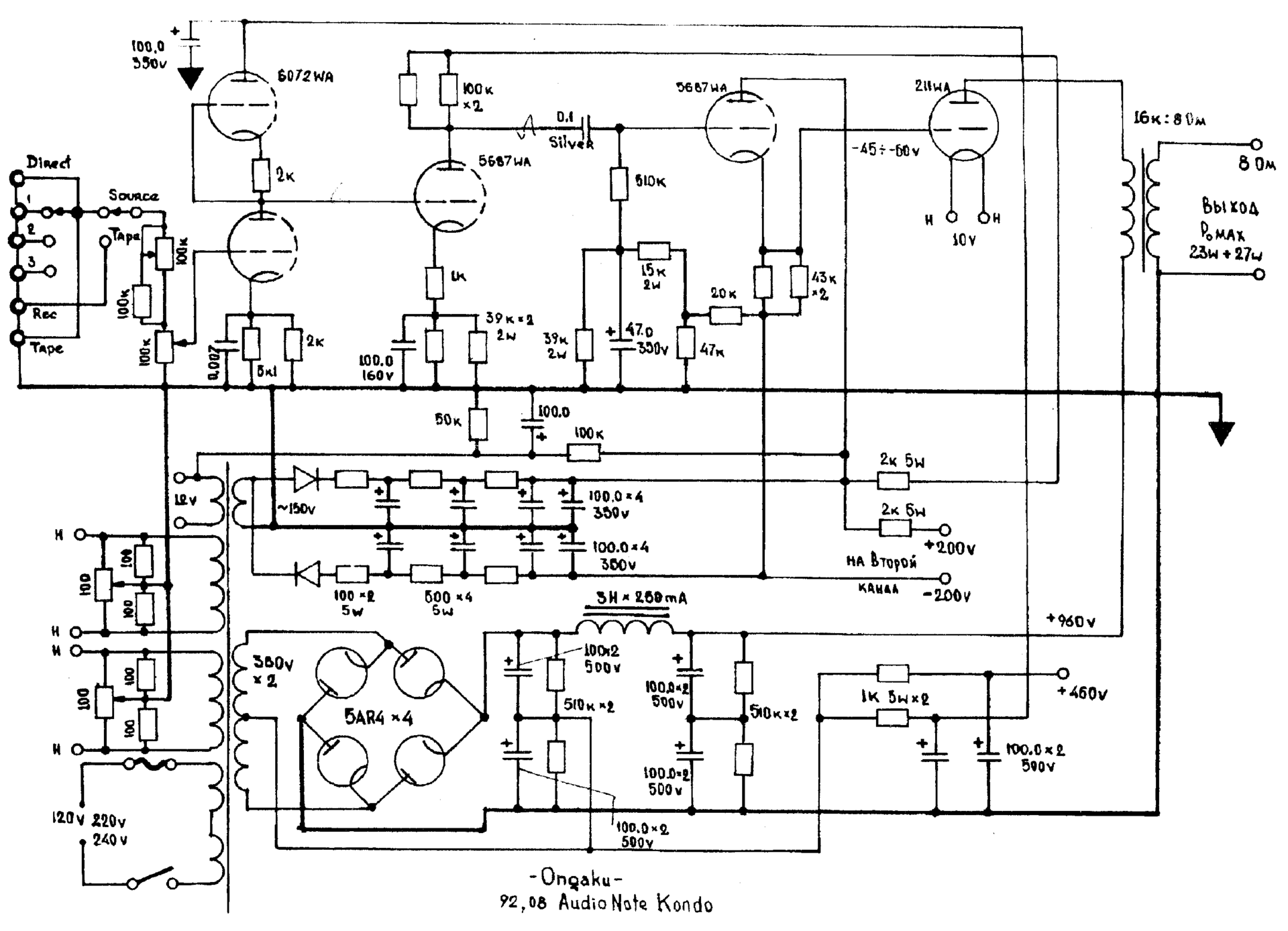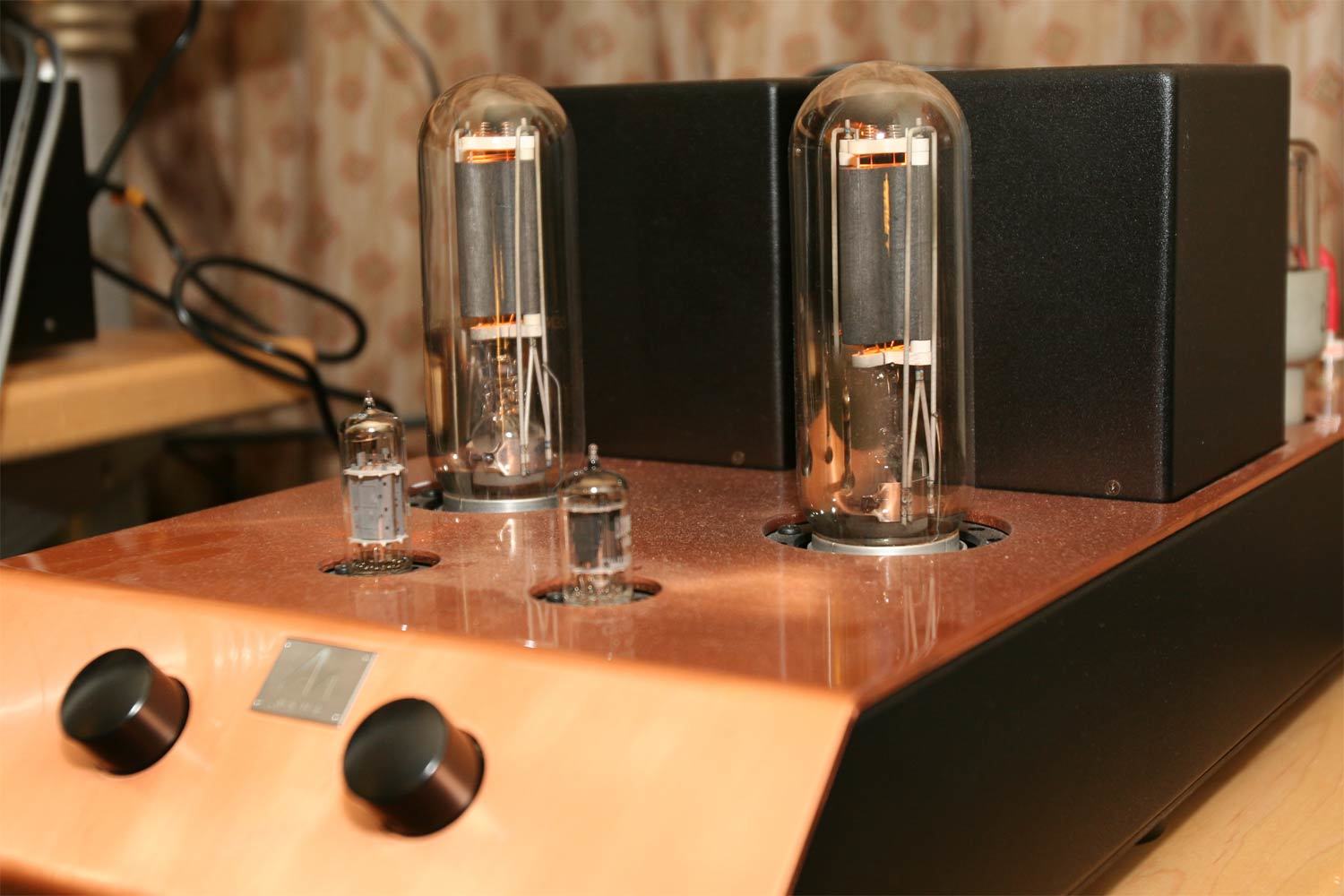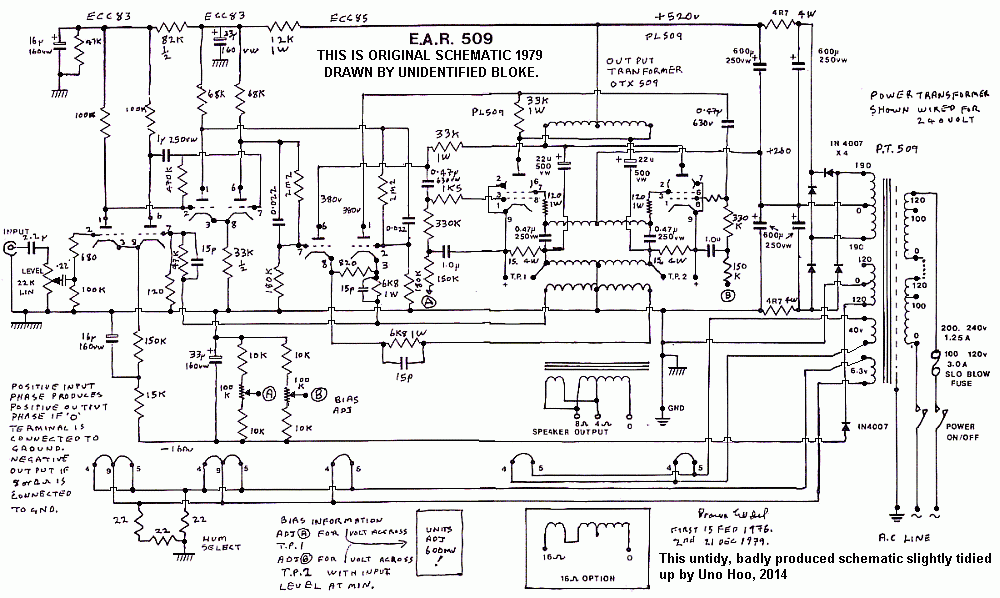Legendary amplifiers: distortion champion, tube long-liver for Paul McCartney, all-metal sheath
This is the final post of the cycle “Legendary Amplifiers” in which I want to touch on modern devices. The review included the most notable developments that determine the significant approaches to the creation of amplifiers in our time. Critics will be less than in previous articles, I believe that it was enough in the cycle (only one device will receive a predominantly negative assessment). For those who like to evaluate the circuitry for 2 out of 3, presented in the review of amplifiers, the originals of the circuits are published.

As sources of information, in addition to the opinions of experts of our company and relatively modest personal experience, I used the publications of such authorities in the field of evaluation of audio equipment as: Dick Olsher, Paul Seydor, Peter Breoninger, Robert Harley (Robert Harley), Vanderkuy (J. Vanderkooy), Lipschitz (SP Lipshitz), publications publications: Stereophile, “Positive Feedback”, “SoundStage!”, “The Absolute Sound Magazine”, resource materials: 2ndhandhifi.co.uk, www .expertcen.ru , www.whathifi.com , stereo.ru., musichall.com.ua, and also own materials Pult.ru.
I will begin traditionally with critical notes about a paradoxical lamp device, which, by the way, is so legendary that it was even mentioned as an example of a canonical commercial TLZ UMZCH on Wikipedia.
')

The device was created by a cult figure for audiophile tube engineering, the master and founder of Audio Note, Hiroyasu Kondo. The Ongaku tube stereo amplifier, developed on direct-heated triodes, had a power (RMS) of 27 watts per channel. The amplifier, which, according to Brioningen: “made a revolution in the minds of audiophiles,” saw the light in 1989. Apparently, the device is still being produced in small batches, at least it is available commercially.

Master Kondo with manic persistence stuffed Ongaku with silver parts and elements, which significantly affected the cost. Almost all Ongaku conductors are made of silver. Also, the noble metal is sufficiently present in the unique handmade capacitors (silver foil) and the output transformer (12 kΩ) of manual winding (silver conductor).

Another interesting feature of Ongaku is the use of original “SWW” wires, in which natural silk is used as an intermediate layer between PVC - an insulator and a conductor made of silver. As the manufacturer explains, "silk is used to suppress unwanted vibrations," which creators do not specify.

The paradox lies in the fact that with admiring feedback from audio journalists, exhibition excitement, silver smugging, all this precious TLL - a miracle from the land of the rising sun has the following characteristics:
And, which has become traditional in this cycle, drumming ...

Price: $ 60,000 (at the time of the start of sales in Japan). Today in Russia this legend of warm lampovig, with a capacity of 27 W (per channel) and SOI 5% (!) Can be purchased for (on average) 7,000,000 rubles. A truly record price per watt, comparable, probably, only with the toroidal Opera Only and Lamma / Shushurin amplifiers.
For comparison, 34 kg (weight of the amplifier) silver of the 999th test costs about 850,000 rubles. Total, the cost of the amplifier can be purchased about 280 kg of silver 999th sample. I did not get to hear Ongaku myself, but colleagues who visited showrooms, where one could appreciate this sample of Japanese greed, answered the question: “what about the divine sound?” Answered with a sarcastic smile.
The amplifier, which will be discussed, appeared in 1979 and is produced to this day. UMZCH almost the same age as the company that released it. Esiteric Audio Research (EAR) appeared in 1976. This quality and repeatedly recognized as a cult, top, etc. Mono UMZCH created a famous engineer, one of the conceptualists of increasing high fidelity Tim De Paravicchini, better known as the developer of studio equipment. Paravicini managed to create a 100 watt tube amplifier, without negative feedback, with characteristics that fully comply with the HI-FI standard.

Subject to repeated laboratory tests, the EAR showed that tube circuitry can provide characteristics comparable to the parameters of transistor systems. The frequency range reproduced by the Paraanicini devil-device goes far beyond the limits of audible low and high frequencies and ranges from 9 to 30,000 Hz (-3 dB) (according to some information, the upper limit of the frequency range reaches 85 kHz). Interestingly, the amplifier turned out quite easy in comparison with its tube peers, the weight of one unit is 18 kg.
Even Sir Paul McCartney appreciated the advantages and impressive design of the amplifier, becoming the owner of a pair of amplifiers from the limited series.

Specifications:
The price is: $ 14,000 for one candy bar, i.e. $ 28,000 for a couple, prohibitively expensive for mere mortals, but quite democratic and affordable for Sir Paul McCartney.
Over the past five years, Arcam has firmly taken its place among the leaders in the production of devices for high-quality sound amplification. A real hit, both among the experts and among ordinary users, was the Full Metall Jacket line (in the literal sense, a shell bullet, in the allegorical one, the Russian equivalent of this stable expression — a load of 200 or “zinc”), named after the film of the same name Stanley Kubrick. The reason for the name served as the design of the amplifier, in which almost all external elements are made of metal.

Not being, in terms of pricing and philosophy, the true High End company, Arcam received a lot of positive feedback from the audiophile community, where the Arcam FMJ A19 amplifier stands out in particular. This UMZCH has repeatedly received the highest awards of specialized exhibitions and the accolades ofpeople with golden ears of cool experts. Not spared amplifier and Russian-language publications. In 2013 - 2015, this product was named the best UMZCH in Britain, the EU and the USA.

The successes of the Arcam FMJ A19 integrated amplifier could be recorded at the expense of hype in the audiophile media, if not for a large number of positive reviews from independent authors, private reviews and, most importantly, the practical absence of negative evaluations. In an attempt to preserve objectivity, I tried to find a detailed negative review about this line and amplifier. Result: I did not find anything but well-deserved reproaches in the absence of digital inputs, unintelligible allegations of insufficient detail in the high-frequency range and low dynamics of low.

The FMJ A19 amplifier (like most of its counterparts in the line) is equipped with a special headphone amplification module, built-in MM phonorecorder, and a toroidal transformer. Thanks to phono-correctors, FMJ A19 was naturally claimed by vinyl lovers. There are 8 inputs to the amplifiers, which makes it related to AV receivers. The use of relatively inexpensive elementary base allowed keeping the cost of this Hi End (manufacturer’s positioning) component within $ 1,500. In general, the cost of other members of the line rarely exceeds $ 4,000, which, given the Hi-End, positioning of FMJ products is surprising.
The subject of the characteristics:
With this material I complete the cycle. Legendary UMZCH not included in my reviews is not enough, but, I believe, all the major trends, both in history and in modern sound amplification were considered. I will return to the topic of amplifiers more than once, in particular, to our unforgettable Soviet past. I sincerely hope that the articles were interesting to read, and that they have brought ideological benefit. I want to believe that truly high-quality, useful, worthy development of talented engineers will become cult and legendary, and soap bubbles based on empty statements will no longer be perceived by consumers. I am convinced that knowledge and pragmatism will make high-quality audio equipment accessible to many, and pricing fair.
I want to express my gratitude to GT users, who highly appreciated the materials, actively participated in the discussions, submitted worthy ideas that they managed to implement in this cycle. Thanks a lot : Ugrum , melchermax , instalator , madf , nickname_nickname , sergku1213 , cherryfake , Jarbird , gxcreator , Palpatin , serg_p , ElvinFox , B0MJE , etc.

As sources of information, in addition to the opinions of experts of our company and relatively modest personal experience, I used the publications of such authorities in the field of evaluation of audio equipment as: Dick Olsher, Paul Seydor, Peter Breoninger, Robert Harley (Robert Harley), Vanderkuy (J. Vanderkooy), Lipschitz (SP Lipshitz), publications publications: Stereophile, “Positive Feedback”, “SoundStage!”, “The Absolute Sound Magazine”, resource materials: 2ndhandhifi.co.uk, www .expertcen.ru , www.whathifi.com , stereo.ru., musichall.com.ua, and also own materials Pult.ru.
Precious Japanese distortion for 7,000,000 rubles
I will begin traditionally with critical notes about a paradoxical lamp device, which, by the way, is so legendary that it was even mentioned as an example of a canonical commercial TLZ UMZCH on Wikipedia.
')

The device was created by a cult figure for audiophile tube engineering, the master and founder of Audio Note, Hiroyasu Kondo. The Ongaku tube stereo amplifier, developed on direct-heated triodes, had a power (RMS) of 27 watts per channel. The amplifier, which, according to Brioningen: “made a revolution in the minds of audiophiles,” saw the light in 1989. Apparently, the device is still being produced in small batches, at least it is available commercially.

Master Kondo with manic persistence stuffed Ongaku with silver parts and elements, which significantly affected the cost. Almost all Ongaku conductors are made of silver. Also, the noble metal is sufficiently present in the unique handmade capacitors (silver foil) and the output transformer (12 kΩ) of manual winding (silver conductor).

Another interesting feature of Ongaku is the use of original “SWW” wires, in which natural silk is used as an intermediate layer between PVC - an insulator and a conductor made of silver. As the manufacturer explains, "silk is used to suppress unwanted vibrations," which creators do not specify.

The paradox lies in the fact that with admiring feedback from audio journalists, exhibition excitement, silver smugging, all this precious TLL - a miracle from the land of the rising sun has the following characteristics:
- Rated power: 27 W + 27 W at 1 kHz;
- Frequency: 8 Hz ~ 21 kHz (+ 0 dB, -3 dB);
- THD: 5%;
- IMD: 11%;
- Input sensitivity: 200 mV RMS;
- S / N ratio: 75 dB;
- Input impedance: 100 kΩ;
- Output impedance: 8 ohms;
- Lamps: 2x211, 2x6072, 2x5687, 4xGZ34;
- Weight: 34 kg
And, which has become traditional in this cycle, drumming ...

Price: $ 60,000 (at the time of the start of sales in Japan). Today in Russia this legend of warm lampovig, with a capacity of 27 W (per channel) and SOI 5% (!) Can be purchased for (on average) 7,000,000 rubles. A truly record price per watt, comparable, probably, only with the toroidal Opera Only and Lamma / Shushurin amplifiers.
For comparison, 34 kg (weight of the amplifier) silver of the 999th test costs about 850,000 rubles. Total, the cost of the amplifier can be purchased about 280 kg of silver 999th sample. I did not get to hear Ongaku myself, but colleagues who visited showrooms, where one could appreciate this sample of Japanese greed, answered the question: “what about the divine sound?” Answered with a sarcastic smile.
EAR Yoshino 509 - tube luxury for rock stars
The amplifier, which will be discussed, appeared in 1979 and is produced to this day. UMZCH almost the same age as the company that released it. Esiteric Audio Research (EAR) appeared in 1976. This quality and repeatedly recognized as a cult, top, etc. Mono UMZCH created a famous engineer, one of the conceptualists of increasing high fidelity Tim De Paravicchini, better known as the developer of studio equipment. Paravicini managed to create a 100 watt tube amplifier, without negative feedback, with characteristics that fully comply with the HI-FI standard.

Subject to repeated laboratory tests, the EAR showed that tube circuitry can provide characteristics comparable to the parameters of transistor systems. The frequency range reproduced by the Paraanicini devil-device goes far beyond the limits of audible low and high frequencies and ranges from 9 to 30,000 Hz (-3 dB) (according to some information, the upper limit of the frequency range reaches 85 kHz). Interestingly, the amplifier turned out quite easy in comparison with its tube peers, the weight of one unit is 18 kg.
Even Sir Paul McCartney appreciated the advantages and impressive design of the amplifier, becoming the owner of a pair of amplifiers from the limited series.

Specifications:
- Power per channel (8 ohms): 100 W;
- Minimum frequency: 8 Hz;
- Maximum frequency: 30000 Hz;
- Input resistance: 25 kΩ;
- Signal to noise ratio: 96 dB;
- THD: 0.5%;
- IMD: less than 1%.
The price is: $ 14,000 for one candy bar, i.e. $ 28,000 for a couple, prohibitively expensive for mere mortals, but quite democratic and affordable for Sir Paul McCartney.
Coffin for competitors - Arcam Full Metall Jacket
Over the past five years, Arcam has firmly taken its place among the leaders in the production of devices for high-quality sound amplification. A real hit, both among the experts and among ordinary users, was the Full Metall Jacket line (in the literal sense, a shell bullet, in the allegorical one, the Russian equivalent of this stable expression — a load of 200 or “zinc”), named after the film of the same name Stanley Kubrick. The reason for the name served as the design of the amplifier, in which almost all external elements are made of metal.

Not being, in terms of pricing and philosophy, the true High End company, Arcam received a lot of positive feedback from the audiophile community, where the Arcam FMJ A19 amplifier stands out in particular. This UMZCH has repeatedly received the highest awards of specialized exhibitions and the accolades of

The successes of the Arcam FMJ A19 integrated amplifier could be recorded at the expense of hype in the audiophile media, if not for a large number of positive reviews from independent authors, private reviews and, most importantly, the practical absence of negative evaluations. In an attempt to preserve objectivity, I tried to find a detailed negative review about this line and amplifier. Result: I did not find anything but well-deserved reproaches in the absence of digital inputs, unintelligible allegations of insufficient detail in the high-frequency range and low dynamics of low.

The FMJ A19 amplifier (like most of its counterparts in the line) is equipped with a special headphone amplification module, built-in MM phonorecorder, and a toroidal transformer. Thanks to phono-correctors, FMJ A19 was naturally claimed by vinyl lovers. There are 8 inputs to the amplifiers, which makes it related to AV receivers. The use of relatively inexpensive elementary base allowed keeping the cost of this Hi End (manufacturer’s positioning) component within $ 1,500. In general, the cost of other members of the line rarely exceeds $ 4,000, which, given the Hi-End, positioning of FMJ products is surprising.
The subject of the characteristics:
- Power per channel: 50 W (8 Ohm) / 90 W (4 Ohm);
- Frequency range: 20 - 20000 Hz (+ -1.5 dB);
- Signal to noise ratio: 105 dB;
- THD: 0.003%;
- IMD: less than 1%.
- In the lineup you can also highlight the Arcam FMJ A29 and Arcam FMJ A39.
Epilogue
With this material I complete the cycle. Legendary UMZCH not included in my reviews is not enough, but, I believe, all the major trends, both in history and in modern sound amplification were considered. I will return to the topic of amplifiers more than once, in particular, to our unforgettable Soviet past. I sincerely hope that the articles were interesting to read, and that they have brought ideological benefit. I want to believe that truly high-quality, useful, worthy development of talented engineers will become cult and legendary, and soap bubbles based on empty statements will no longer be perceived by consumers. I am convinced that knowledge and pragmatism will make high-quality audio equipment accessible to many, and pricing fair.
I want to express my gratitude to GT users, who highly appreciated the materials, actively participated in the discussions, submitted worthy ideas that they managed to implement in this cycle. Thanks a lot : Ugrum , melchermax , instalator , madf , nickname_nickname , sergku1213 , cherryfake , Jarbird , gxcreator , Palpatin , serg_p , ElvinFox , B0MJE , etc.
Source: https://habr.com/ru/post/370281/
All Articles